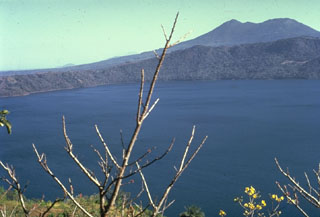Report on Apoyo (Nicaragua) — January 1988
Scientific Event Alert Network Bulletin, vol. 13, no. 1 (January 1988)
Managing Editor: Lindsay McClelland.
Apoyo (Nicaragua) No fumarolic activity; lake temperature measured
Please cite this report as:
Global Volcanism Program, 1988. Report on Apoyo (Nicaragua) (McClelland, L., ed.). Scientific Event Alert Network Bulletin, 13:1. Smithsonian Institution. https://doi.org/10.5479/si.GVP.SEAN198801-344802
Apoyo
Nicaragua
11.92°N, 86.03°W; summit elev. 600 m
All times are local (unless otherwise noted)
No fumarolic activity or hot springs were observed 18 January 1988 at locations previously reported active. Lake surface temperature was 28.2-29.1°C at 0940.
Geological Summary. The scenic 7-km-wide, lake-filled Apoyo caldera is a large silicic volcanic center immediately SE of Masaya caldera. The surface of Laguna de Apoyo lies only 78 m above sea level; the steep caldera walls rise about 100 m to the eastern rim and up to 500 m to the western rim. An early shield volcano constructed of basaltic-to-andesitic lava flows and small rhyodacitic lava domes collapsed following two major dacitic explosive eruptions. The caldera-forming eruptions have been radiocarbon dated between about 21,000-25,000 years before present. Post-caldera ring-fracture eruptions of uncertain age produced lava flows below the scalloped caldera rim. The slightly arcuate, N-S-trending La Joya fracture system that cuts the eastern flank of the caldera only 2 km east of the caldera rim is a younger regional fissure system structurally unrelated to Apoyo caldera.
Information Contacts: B. van Wyk de Vries, H. Rymer, and G.C. Brown, Dept of Earth Sciences, Open Univ; P. Hradecky and H. Taleno, INETER.

